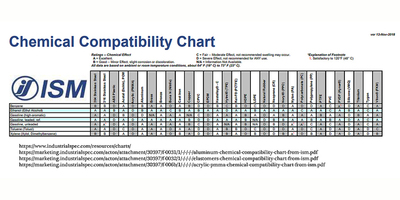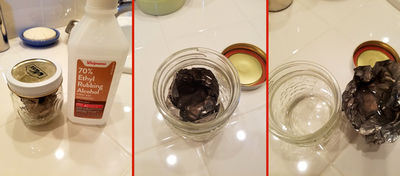Testing Anti-Ethanol Tests - UPDATED with Replies
Here's what happens when you do a little analysis
By Marc J. Rauch
Exec. Vice President/Co-Publisher
THE AUTO CHANNEL
 Marc Rauch |
Todd Osgood produces test videos that he publishes on YouTube under the name PROJECT FARM. His videos test all kinds of things, sort of like the television series "Myth Busters." Todd specializes on testing tools, equipment, and products used around the home and farm or ranch. He reviews LED lights, roto tillers, how to avoid smelling like your livestock, and a bunch of things related to engines. The hallmark of Todd's videos is the preparation he puts into the videos, and the extent he goes to to demonstrate the items(s) he's reviewing. I haven't watched all of them myself, but I've watched a lot of them. I've corresponded with Todd via email, and I've posted comments on the comments section under the videos. If you're into mechanical stuff, you'll like Todd's videos.
This past Monday, just a couple of days ago, Todd posted a video titled "Does Fuel Stabilizer Prevent Ethanol Damage? Let's find out!"
 |
SPOILER ALERT! The video reveals two things: The first is that the video shows that the Lucas product doesn't work. This didn't surprise me considering the reports I've written about other similar products. More about this shortly.
The second thing is that the conclusions that Todd draws in his tests is that ethanol causes more corrosion than gasoline and gasoline's associated components (called aromatics). This surprised me. It surprised me because I know it to be untrue and quite impossible.
You can watch the video right now, or wait until you finish reading my comments and then watch it. It's worth watching, more than once.
Knowing that Todd's conclusions were incorrect, I wrote Todd an email that analyzes his test and what I believe went wrong (yes, I know that sounds arrogant, but when you know that 2 plus 2 equals 4, you can announce it with some assurance). The following is my letter to Todd:
Reply to Todd Osgood
RE: Does Fuel Stabilizer Prevent Ethanol Damage?
Hi Todd -
I always enjoy watching your videos. I respect and appreciate the time you put into doing these tests. The results of this test are interesting for multiple reasons, and if there is a "big loser," it might be Lucas and their product, which appears to not do anything other than taking money out of consumers' wallets.
I recently wrote and published two reports about aftermarket engine treatment products. As I point out in both articles, the active ingredients in the products are all more corrosive than ethanol (as rated by multiple chemical testing firms). Therefore, my conclusion is that ethanol can't be the cause of the cited problems because the active ingredients with or without the gasoline and aromatics would have caused the problems well before ethanol could have. Your video appears to verify this. My two articles are:
-
Famous Manufacturer of Anti-Ethanol Additives Proves Ethanol's Safety and Benefits
Automotive Aftermarket Saturated with Snake Oil Engine Additives
In your video, part of your audio description of the "corrosion" are the paint flecks. Considering that ethanol is a solvent, this effect on any paint should be normal. However, the gasoline alone could also have done this to the paint since gasoline and the other ingredients in gasoline (benzene, toluene, and xylene) are also solvents. The "secret sauce" active ingredient in the Lucas product would also be a solvent because it's most likely a petroleum distillate of some type.
What you describe as "build up" and a "jelly-like" substance looks to me like emulsified paint, which is what you would expect to have in a sealed jar that contains a solvent with a substance that has paint on it. This is not "metal corrosion." I acknowledge that since I was not in the room with you that I can't confirm if it's emulsified paint that hasn't dried, but that's what it looks like.
Among the questions that should be addressed are: Why did you use a metal that has paint on it, as opposed to just the raw metal? I'm not familiar with carburetors that are painted.
You also have to ask or address the issue of solvent quality...in other words, because all solvents are not equal in strength, could the ethanol simply be a more effective paint solvent than the gasoline, the aromatics, or whatever is used by Lucas? Therefore, if the "emulsified paint" in one jar is different than in another, might it not simply be caused by the qualitative differences in the solvent?
The question of the paint on the aluminum brings up the issue of "controls." In my opinion, you should have had at least three controls in your test: You should have had a jar with pure ethanol (no gasoline at all) and a piece of the metal; you should have had a jar with just water and a piece of the metal; and you should have had samples of what the aluminum pieces looked like before adding it to the liquids, or some metal samples that were never subjected to the test.
In a separate email, I am sending you a couple of photographs and a link to a short video that I just took of a very simple test of my own that I've been conducting for the past three years. This test was instigated because of the large number of people who claim that ethanol will melt rubber and plastic, and corrode aluminum. For those people reading my comments on YouTube, they can see the video and photos on TheAutoChannel.com website.
For my test, I took 70% ethyl alcohol (ethanol) and put it in a sealed jar with some common aluminum foil. The ethyl alcohol came from a plastic bottle of ethyl rubbing alcohol that I purchased from a local Walgreens pharmacy. It contains 70% ethyl alcohol and water, but no gasoline or aromatic of any type. It does contain a very small amount of ingredients to discourage anyone from drinking it.
By the way, 70% ethyl alcohol would be equivalent to the lowest range of ethanol in E85 fuel (E85 can legally contain only 70% ethanol and still be labeled E85). In any event, it's certainly more ethanol than the legal ethanol range contained in E10 or E15.
The bottle was not damaged or distorted in any way when I purchased it. It has not deteriorated in any way in the years since I have had it. The plastic did not melt. The bottle is not as full as it was because I used some of the contents for my test, and because occasionally I have used the ethyl alcohol for all the things it can be used for, such as disinfecting bruises and cleaning sensitive electronic equipment. The photos show the aluminum foil with the alcohol. There is no emulsified paint, or jelly-like substance of any kind. There is no evidence of "corrosion." The aluminum is not damaged, it is intact, although it is tarnished. Water by itself will tarnish aluminum over time. We all know that water is corrosive, as is any liquid. Of course, the sun and wind are also corrosive.
The video shows the alcohol in the glass jar and then being poured into the jar from the aluminum cup. There are no bits and pieces of metal. The liquid is completely clear. My test can be conducted by anyone anywhere in the world. I confidently say that their results will be the same as mine.
Todd, you state that ethanol is hygroscopic and that it attracts water. It is correct that ethanol (alcohol) is hygroscopic, however, it is not correct to say that it attracts water. Alcohol "absorbs" water it comes in direct contact with it, it does not attract water. The definition that a hygroscopic substance "attracts water from the air" is incorrect. Incidentally, gasoline is also hygroscopic, so any derisive point made about ethanol regarding the fallacious sucking water out of the air characteristic is rendered meaningless because the same derisive comment could be said about gasoline - if it was true. If any water appeared in your test jars it was because of condensation, which can occur with or without the presence of any other liquid. I cover all this in another report I wrote and published about 4 years ago:
You mention that the rubber material used in "pre-ethanol" gasoline blends was different than the rubber used now. What is that difference? What are the different rubbers called, if you know? Have you compared these different rubbers on any chemical comparison databases? I believe you'll find that there is no universal difference in the types of rubber used in pre-1995 and post 1995 engines, except for the use of Viton rubber, which was invented in the 1950's because of the corrosion caused by gasoline and aromatics (not ethanol).
On this same point, some years ago I wrote and published a report specifically about ethanol and small engines. I recently updated the story to include a small internal combustion engine, made out of aluminum, that
has been in regular use around the world by millions of people for many years. The fuel used for these engines is alcohol, specifically methanol, with a small amount of nitromethane, and oil for lubrication. The
engines do not corrode or deteriorate because of the methanol, but they do get damaged from the deposits left by the oil. The deposits are the carbon deposits typically left from gasoline and diesel. The deposits are
gummy, and they harden into a varnish-like substance. These engines are the engines used in model cars, planes, and boats. The engines are miniaturized versions of full size internal combustion engines. A point that
should interest you is that methanol is a bit more corrosive than ethanol, and methanol is not as corrosive as gasoline and aromatics. Since methanol does not corrode these aluminum engines there is no reason to
believe that ethanol will corrode full size engines ahead of any damage done by gasoline and aromatics.
Lastly, you provide a demonstration of old fuel, and make statements about ethanol going bad. Gasoline goes bad, ethanol virtually never goes bad. The simplest way to test this is to open any old bottle of drinking alcohol regardless of whether it is still sealed or previously opened. It will taste and smell exactly as if did when it was originally purchased. Open a bottle of ethyl rubbing alcohol (like the one in my photo). Regardless of when you purchased it, it will have the same antiseptic and solvent qualities. Ethanol does not go bad...something in the ethanol, such as gasoline and aromatics will go bad.
Having said this, I acknowledge that your video shows the ethanol-gasoline fuels not performing as well as the ethanol-free gasoline. From this demonstration alone, I can't possibly make the generic determination that ethanol would have a long term effect negative effect on old gasoline, and I can't imagine that you could either. However, the real bottom line is that no fuel should be allowed to sit in an idle engine for nine months; it is a sure recipe for disaster. On the other hand, perhaps what your demonstration showed for the second time is that Lucas' product may be worthless (this is the conclusion I arrived at with other similar products in the two reports I cited above).
After analyzing all of the foregoing (your video, my reports, photos, and video), the proof is that ethanol does not, and can not damage engines and engine components ahead of any damage caused by gasoline and aromatics. Moreover, this shows that products that claim to "protect" against the effects of ethanol are nothing more than snake oil.
Todd, I look forward to any response you or any other KNOWLEDGEABLE reader would like to make.
Thanks for your time.
Marc
THE AUTO CHANNEL
From Todd - Project Farm
Hi Marc,
Great to hear from you!
What I saw with my own eyes with my testing is indeed corrosion, and I'm 100% certain of it. In my testing, the untreated E10 fuel did experience more corrosion than the E10 fuel treated with Lucas fuel
Conditioner. As for the E85, the fuel stabilizer didn't seem to do any good at preventing corrosion compared to the untreated E85. The E85 fuel did indeed cause a lot of damage. The non-ethanol fuel was
the only fuel that did not cause any visible corrosion. Since I only tested Lucas, I just began a long-term test including several other products. Maybe some of the other fuel stabilizers that I'm testing
will cause more harm than good We'll find out in about a year.
You have a very strong opinion that ethanol is harmless and won't cause corrosion. That's fine and no worries. It's perfectly fine for there to be different opinions on matters and sincerely I wish you
the best in all you do.
Thanks again and best regards,
Todd
To Todd - Project Farm
Hi Todd -
Thanks for your quick reply to my email. However, I have to say that I have some mixed feelings about the speed of your reply because I feel that you may not have had time to fully consider my response to your video, which included other videos, compatibility charts, procedural questions relating to test controls and the use of metals with paint on it, as well as just good old common sense experience and research that includes all the years that ethanol fuels have been used in Brazil and Europe. I don't know if you ever read my paper on the use of "power alcohol" fuel for 6 decades in Britain, but if you haven't you may find it insightful (CLICK HERE TO READ).
As I wrote in my last email, I can't second guess what you saw, or what you may have thought you saw - after all I wasn't in the room with you. But I have to question your interpretation of what you saw. My own test with ethanol and aluminum foil showed none of the residual material that was shown in your video, yet my test has gone on for three years, not just nine months. Furthermore, one of the videos included in my Small Engine report (produced and posted by Erron Spalsbury) demonstrated what happens with a piece of aluminum that has soaked in ethanol for nearly nine years, and yet it has none of the effects that you call corrosion. I think it clearly confirms the results of my test while disputing the validity of your conclusions.
Erron's 2nd video includes rubber added to his test jar and after a year it doesn't show the corrosion that your video demonstrates. Given the results of my video and Erron's videos I think it should at least cause you to consider how and why your results were so different.
Of course the biggest difference between your test and Erron's or mine is that we didn't include any third party ingredient in the jar: the Lucas product. We just had ethanol and the metals. So this speaks to the reason why having controls on your test would have been helpful to determine what exactly caused the visible effects shown in your test. If we can assume that your test, my test, and Erron's tests were all conducted in good faith, then the conclusion must be that the gasoline and aromatics along with the petroleum distillates in the Lucas product were responsible for what you deem is corrosion. If we add in two of the other videos I included in my Small Engine report (the videos produced and posted by Jacob Kaul), he did use ethanol-gasoline blends, not just ethanol. Yet, Jacob's tests also didn't show any deteriorated rubber material (I do recognize that his test was for a shorter duration than yours).
It is true that I have very strong opinions about ethanol. However, my opinions do not color how I perceive the results of ethanol; it was the results of my research and practical experience with ethanol that engendered my opinions. And I never say that ethanol is harmless and won't cause corrosion, I always say that all liquids are corrosive and that all moving parts break down over time. What I argue is that the negative corrosive effects of gasoline and aromatics - that have been present since the invention of gasoline - are being unfairly blamed on ethanol. Given enough time, ethanol on its own may cause significant corrosion to a metal or rubber substance, but long before the ethanol will get that chance gasoline and aromatics will cause the corrosion.
Remember, ethylene bromide had to be added to leaded gasoline to stop the excessive corrosion caused by tetraethyl lead. Viton rubber was invented by Dupont to eliminate the corrosive problems caused
by gasoline with and without TEL. And as Victor Wilfred Pagé wrote 100 years ago in his dozen or so books and manuals about automobiles:
-
"Denatured alcohol is without doubt the best substance to use as it does not have any destructive action on the metals or rubber hose, will not form deposits of foreign matter, and has no electrolytic effect."
Also, you seem to have completely skipped over the hygroscopic issue. I would have liked to hear your take on this.
Please feel free to reply...I hope you will.
Regards.
Marc
THE AUTO CHANNEL




